
| Home | Deepsky Atlas | TheAstronews | Links | Solar System | ||||||

Hawaiian Astronomical SocietyConstellations: Fornax -- Death of an Element |
||||||||||
Nicolas Louis de Lacaille (1713-1762) named this constellation for the accomplishments of his good friend and famous chemist Antoine Laurent Lavoisier (1743-1794). He met Lacaille when studying Astronomy at Mazarin College. Lavoisier's accomplishments include championing the idea that mass is preserved in all chemical reactions. This had a profound effect in his examination of combustion. The chemist, Georg Stahl (1660-1734) had theorized that burning materials consisted of a fire element called phlogiston. The material left after burning was called the residue. Subtract the weight of what was missing, and that was the missing phlogiston. He stated that rust formed as a result of "burning" iron.
Lavoisier realized it was not that simple. He did discover a common element in both combustion and rusting: oxygen. He also identified the element in several other reactions and compounds, including water.
In addition to his scientific efforts, Lavoisier worked for the French national treasury. He worked for education reform, and pushed for the adoption of a metric system of measurement. He also worked in the Ferme General, a private firm contracted by the government to collect taxes. This proved to be his downfall. During the French Revolution, Jean Paul Marat, backed by other radicals, attacked his involvement in the firm, and he was guillotined in 1794.
He leaves us the Metric System, modern chemistry, and Fornax - his combustion furnace.
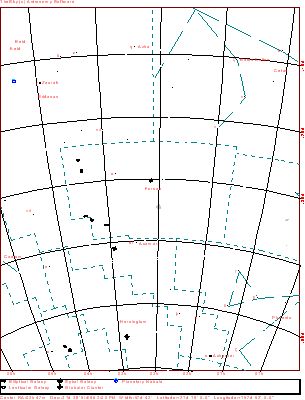
Click the map for a 912x1200 version of the above. Click here for a map better suited for use in the field.
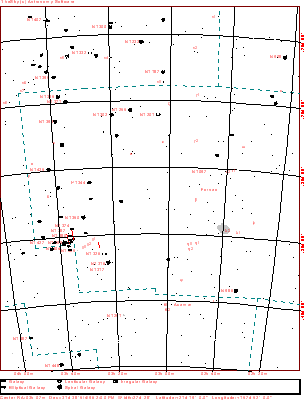
Click here for a map better suited for use in the field.
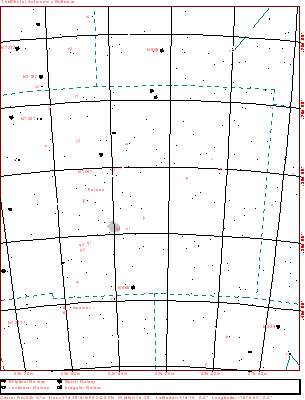
Click here for a map better suited for use in the field.
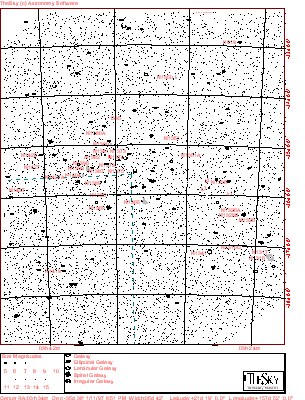
Click here for a map better suited for use in the field.
 36k, labeled JPEG Four significant objects inhabit this mosaic created from Digital Sky Survey downloads. From south to north: 36k, labeled JPEG Four significant objects inhabit this mosaic created from Digital Sky Survey downloads. From south to north:
NGC1398 (Bennett 19a) is a spiral galaxy located 1.6° north of Tau Fornacis. Dreyer describes the galaxy as quite bright (mag. 10.4), quite large (7.1'x5.3'), round, with a pronounced nucleus. The given size includes the fainter spiral arms. |
 1.3° to the WNW is the planetary nebula NGC1360 (Bennett 15). Dreyer describes a mag. 8 star embedded in a bright (mag. 7.1), large (9'x6') nebula, extended north to south. Other sources list the central star as closer to mag. 11. A nebula filter helps bring out darker patches in the nebulosity. 1.3° to the WNW is the planetary nebula NGC1360 (Bennett 15). Dreyer describes a mag. 8 star embedded in a bright (mag. 7.1), large (9'x6') nebula, extended north to south. Other sources list the central star as closer to mag. 11. A nebula filter helps bring out darker patches in the nebulosity.
A further degree NNE lies NGC1371, a galaxy with the typical Dreyer description of fairly bright(mag. 11.5), fairly large (5.6'x3.9'), very little extended, and fairly abruptly brighter toward the middle. Users of 13" instruments have claimed to see a subtle dust band. NGC1385 lies 42' to the NE. Dreyer describes it as: Fairly bright, fairly small, round, gradually westward much brighter middle.
The image to the upper left is a mosaic of six downloads from the Digital Sky Survey. It covers a little over 2° from north to south. The drawing of NGC1360 is by Richard Jakiel, recording his observations through a 20" reflector.
|
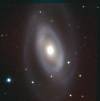 14k JPEG NGC1350 (Bennett 14a) is a spiral galaxy located 2.6° north of NGC1365. Dreyer describes the galaxy as bright (mag. 11.3), large (5.2'x2.8'), moderately extended (p.a. 30°), with a very much brighter middle, and a round nucleus. 14k JPEG NGC1350 (Bennett 14a) is a spiral galaxy located 2.6° north of NGC1365. Dreyer describes the galaxy as bright (mag. 11.3), large (5.2'x2.8'), moderately extended (p.a. 30°), with a very much brighter middle, and a round nucleus.
Photograph by the Ohio State University Bright
Galaxy Survey, part of the Astronomical Picture Gallery.
|
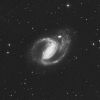 63k JPEG NGC1097 (Bennett 10, Caldwell 67) is a spiral galaxy located 5.7° WSW of Alpha Fornacis. Alpha is the brightest star (mag. 4) shining in a barren region. Dreyer describes the galaxy as very bright (mag. 9.9), large (9.4'x6.4'), very elongated (P.A. 151), with a pronounced nucleus. From the Digital Sky Survey. 63k JPEG NGC1097 (Bennett 10, Caldwell 67) is a spiral galaxy located 5.7° WSW of Alpha Fornacis. Alpha is the brightest star (mag. 4) shining in a barren region. Dreyer describes the galaxy as very bright (mag. 9.9), large (9.4'x6.4'), very elongated (P.A. 151), with a pronounced nucleus. From the Digital Sky Survey.
|
| Map | Printable Map |
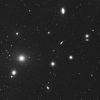 106k JPEG NGC1399 (Bennett 19) is the brightest and largest of a host of galaxies in this image that spans the border of Fornax and Eridanus. Dreyer calls this elliptical very bright (mag. 9.8), fairly large (3'x3'), with a pronounced core. He also calls it very resolvable!? Perhaps he refers to a foreground star that sits 20" north of the nucleus. 1399 sits in the far left (east) of the photograph. Just below it (and accross the border in Eridanus) lies NGC1404 (mag. 10.9). The galaxy pair NGCs 1387 (Bennett 18, shining at mag. 11.7) and 1379 (mag. 12), present also in the image below lies due west of NGC1399. Just below (south) lies NGC1389. Just above, lies the much elongated NGC1381 (mag. 12.6). To the far right lies the pair NGCs 1374 (mag. 12 and top) and 1375 (mag. 13 and bottom). At the top of the image lies the elongated NGC1380 (Bennett 17, shining at mag. 11). 106k JPEG NGC1399 (Bennett 19) is the brightest and largest of a host of galaxies in this image that spans the border of Fornax and Eridanus. Dreyer calls this elliptical very bright (mag. 9.8), fairly large (3'x3'), with a pronounced core. He also calls it very resolvable!? Perhaps he refers to a foreground star that sits 20" north of the nucleus. 1399 sits in the far left (east) of the photograph. Just below it (and accross the border in Eridanus) lies NGC1404 (mag. 10.9). The galaxy pair NGCs 1387 (Bennett 18, shining at mag. 11.7) and 1379 (mag. 12), present also in the image below lies due west of NGC1399. Just below (south) lies NGC1389. Just above, lies the much elongated NGC1381 (mag. 12.6). To the far right lies the pair NGCs 1374 (mag. 12 and top) and 1375 (mag. 13 and bottom). At the top of the image lies the elongated NGC1380 (Bennett 17, shining at mag. 11).
|
From the Digital Sky Survey. Image on the right is from the Hubble Space Telescope. |
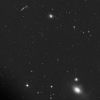 80k JPEG NGC1316 (Bennett 14), its bar just visible in photographs, anchors the western end of the Fornax cluster. Dreyer calls it very bright (mag. 8.9), quite large (7'x5.5'), with a pronounced core. It sits in the bottom, right (south-west) of the photograph. Just north is the mag. 11.9 NGC1317. 47' NNE from 1316 lies the mag. 11.4 NGC1326. In the top, left of the photograph (from left to right) lie the more difficult NGC1326-B (mag. 13.6) and A (mag. 13.8). Many more galaxies show in this image from the Digital Sky Survey. 80k JPEG NGC1316 (Bennett 14), its bar just visible in photographs, anchors the western end of the Fornax cluster. Dreyer calls it very bright (mag. 8.9), quite large (7'x5.5'), with a pronounced core. It sits in the bottom, right (south-west) of the photograph. Just north is the mag. 11.9 NGC1317. 47' NNE from 1316 lies the mag. 11.4 NGC1326. In the top, left of the photograph (from left to right) lie the more difficult NGC1326-B (mag. 13.6) and A (mag. 13.8). Many more galaxies show in this image from the Digital Sky Survey.
|
If you have any questions about the Hawaiian Astronomical Society
please
(link requires javascript).